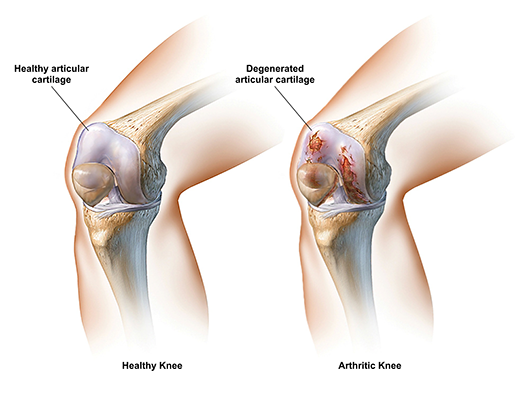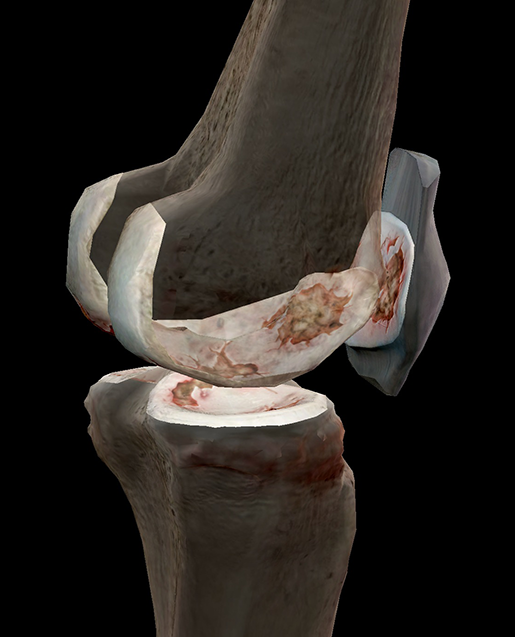New Year, New Me, Old Knees: Degenerated Articular Cartilage (Osteoarthritis)
Posted on 1/12/18 by Suchita Chadha
The new year's air is full of resolutions, that post-holiday glow, and wallet-emptying gym memberships. It's the end of your first workday of the year and you're armed with new workout clothes as you stride into the gym by the office. Music is pumping energy into your veins and you're ready to embark on a journey of good health and self-care. Watching your form in the mirror, you drop carefully in a lunge, only to cringe from the pain coursing through your knees. There goes that goal…or not?
Osteoarthritis—the most common type of arthritis—is a result of degenerated articular cartilage, causing pain, swelling, and reduced motion. While it can occur in any joint, one in two adults will develop symptoms of knee osteoarthritis during their lives, according to The Arthritis Foundation.* It's a chronic condition with no definitive treatment option, but there are ways to manage symptoms and still keep your new year’s resolution.
So what's articular cartilage, why is it degenerating, and how do you live forever? Well, that last one's a secret, but I can tell you about the first two.
Cartilage
Let's back up a bit. Cartilage is a type of connective tissue, like tendons and ligaments, which plays a key role in our musculoskeletal system.
There are three classifications of cartilage:
- Elastic Cartilage—this is the most flexible kind (think of your outer ears and epiglottis)
- Fibrocartilage—this is the strongest kind and provides support (found in the pubic symphysis and in between vertebrae)
- Hyaline Cartilage—with a glass-like ("hyaline") appearance, this is the most common kind
Unlike other connective tissues, cartilage doesn't have any nerves or blood vessels. This means that injury directly and only to the cartilage wouldn't cause pain. However, the damage generally snowballs into surrounding regions, and that's when the problems arise.
Articular Cartilage
This is a kind of hyaline cartilage that covers and protects the area where bones articulate. In the knee, articular cartilage is located on the femur (thigh), tibia (lower leg/shin), and patella (kneecap).

Image from A&P 6.
When it's healthy and whole, articular cartilage prevents friction between the bones. In weight-bearing joints like the knees, the cartilage also helps distribute the load.
Due to the great stress on the patellofemoral joint during resisted knee extension, the articular cartilage of the patella is among the thickest in the human body. While the other types of cartilage aren't fragile by any means, neither elastic nor fibrocartilage can withstand the movement that articular cartilage manages on a regular basis, even though fibrocartilage is considered the strongest of the three.
Osteoarthritis
"Arthritis" is a general term to refer to joint pain or disease. Osteoarthritis is a chronic disease that occurs when tissue damage occurs to ligaments, menisci, and most importantly, the articular cartilage— to the extent that bones rub against each other.
With age, overuse, or injury, the articular cartilage deteriorates and the tissue becomes frayed, exposing the bone and causing pain. Due to the absence of blood vessels, articular cartilage is very slow to heal, so consistent or prolonged re-injury to the articular cartilage will speed the deterioration.

Degenerated articular cartilage in the knee. Image from Muscle Premium.
At a certain point of deterioration, it's possible that fibrocartilage will grow in place of the articular cartilage, but since it's not as durable or smooth, movement of the joint will still cause pain.
Symptoms of osteoarthritis include:
- Pain (obviously)
- Quadriceps weakness (these are muscles on the front/sides of the femur, critical to walking)
- Joint effusion (when there's an increased amount of synovial fluid in the joint)
- Joint stiffness (moving after long stretches of inactivity can be particularly difficult)
- Decreased proprioceptive function (this is your sense of physical self)
- Altered gait
Another structural change that can occur is the formation of osteophytes, or bone spurs. These form along the edges of the joint and impair range of motion.
So instead of that knee-breaking lunge, what can you do to keep that gym membership active longer than a month? Unfortunately, there is no definitive solution that can completely fix osteoarthritis, but there are medical and lifestyle treatments that aid in the management of pain.
The most important thing to know is that not exercising will actually make it worse so don't let it become the excuse that keeps you out of the gym. The right type of physical activity will help your joint muscles strengthen and take some stress off the articular cartilage. Improving flexibility and range of motion will also help ease the pain and stiffness.
Your new year's fitness resolution will help in another way too. When you've got osteoarthritis of the knees, it's important to reduce or maintain a healthier weight. Make sure you talk to your doctor or physical therapist so they can advise on the best stretches and exercises. If you're thinking of making major dietary changes, you'll also want to consult your doctor so that you don’t miss out on essential nutrients.
Despite the pain, osteoarthritis shouldn’t rule your life. It's time to get cracking at the gym so that your #newyearsresolution photo looks just perfect.
Be sure to subscribe to the Visible Body Blog for more anatomy awesomeness!
Are you a professor (or know someone who is)? We have awesome visuals and resources for your anatomy and physiology course! Learn more here.
Additional Sources:




